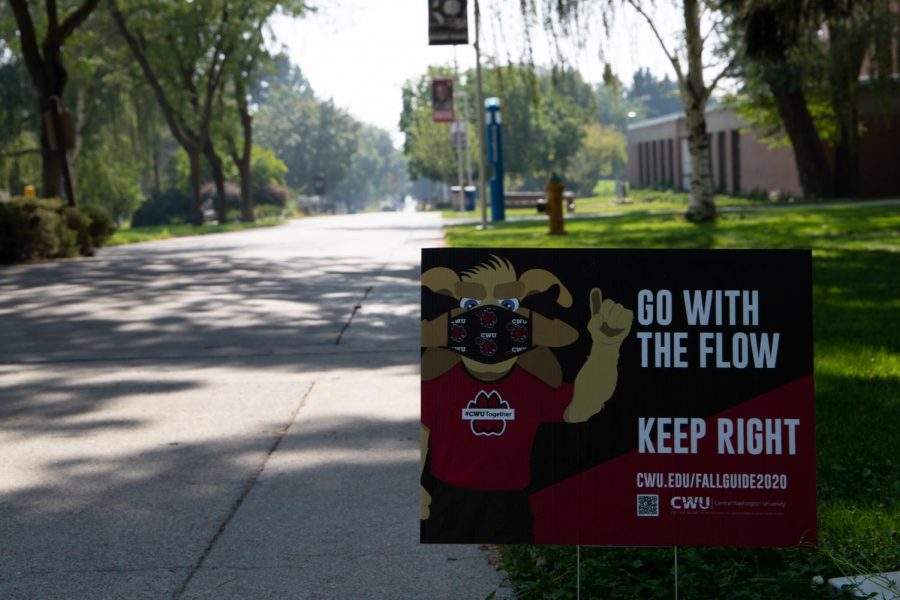COVID-19 health and safety measures enforced on campus
“Go with the flow” CWU sign prompting students to stay safe and distanced
September 15, 2020
Following the decision to open campus during the pandemic, a number of health and safety measures have caused changes on campus. Many of these have taken the form of physical changes made to spaces on campus alongside a refocusing of disciplinary guidelines that encompass new risks occupying these spaces will bring.Many spaces have had furniture reconfigured in ways that encourage, if not require, social distancing. Seats in classrooms have been separated, walkways and queues have been clearly marked and dorms will now only house a single student per room.
Air circulation and filtration has also been tested in all campus buildings. Some classrooms from several buildings, including Lind Hall, will not be utilized during fall quarter due to lack of adequate circulation or filtration.
According to an employee FAQ page on the CWU website, HVAC systems are being reconfigured to run fully on fresh air, instead of recirculating air, where it’s possible to do so. Portable filtration systems, outdoor dining and pop-up outdoor classes are also being considered for fall quarter.
Additionally, cleaning protocols have been increased and refocused. Resources have been shifted to cleaning high volume areas more often, according to James Jankowski, director of the project management office.
“Especially classrooms, they’ll be disinfected daily,” Jankowski said. “Obviously high touch areas like door handles, elevators, those things are all getting touched multiple times a day. Disinfected.”
Signs have also been put up around campus, both to direct foot traffic in a way that maintains safe distances and to remind students and employees to practice safe behaviors.
To reduce campus density, the number of students living on campus for fall quarter was limited to just over 2,000, about half of how many are normally housed, due in large part to a decision made by President Gaudino and the board to move to single occupancy. The more CWU can limit density, Jankowski said, the safer everyone will be.
“At the same time, [we’re] trying to balance providing a college experience,” Jankowski said. “It’s a social institution and so we want to do this the best we can.”
CWU does have repercussions for employees and students who will not adhere to health and safety guidelines, but both Jankowski and Staci Sleigh-Layman, executive director of human resources, said the first approach should be to show kindness and give others the benefit of the doubt.
“We understand the politicalising (sic) of all of this. We really want it to be supportive, and to be kind to one another,” Jankowski said. “In the event, however, that if someone is refusing to, whether it’s an employee or a student, … If their behavior is putting others at risk, then it becomes a health and safety issue. And we have policies and protocols around that, and those will be addressed appropriately.”
If someone is purposefully not following the new safety protocols and are not responsive to kindness, Jankowski said a confrontation should not be the next step.
“I really just want to emphasize a lot of the message is about, again, being kind. Remember this is a hard situation for everyone,” Jankowski said. “It doesn’t matter what political side you’re on … we’re all trying to make it as normal as possible, trying to have the best experience as possible, while keeping everyone as safe as possible.”
Faculty have been directed by the employee FAQ to direct students who come to class without a mask to the SURC info desk to obtain one or to leave the classroom. If the student refuses to wear a face covering and to leave, the employee is instructed to dismiss the class and submit a Student of Concern Report to Student Rights and Responsibilities (SRR).
“It is important to engage in a way that does not escalate the situation and frames the conversation around public health and wellness for all members of the community including faculty and students,” the FAQ reads.
SRR will contact the student and discuss the noncompliant behavior before the student will be allowed to return to the classroom.
“I think we’re putting ourselves in probably the best position to be successful. Whether we will or won’t be remains to be seen. We’ll just have to see how things play out,” Jankowski said. “But I think all the preparations, from all the physical changes, to all the preparing mentally, to putting the plans in place, I really feel good about it.”


Bob Arctor • Sep 21, 2020 at 9:22 pm
Well the daily record beat you guys to the story…
https://www.dailyrecordnews.com/news/cwu-working-to-mitigate-spread-of-positive-covid-19-cases-during-return-to-campus/article_1b813749-52b6-511f-ada1-25dff1f0f318.html
Mr fro • Sep 21, 2020 at 9:06 pm
I’m afraid our numbers are going to skyrocket… There was already an outbreak but nothing from the University about it. Now we’ve got 747 pending tests in our county. Be safe everyone out there.